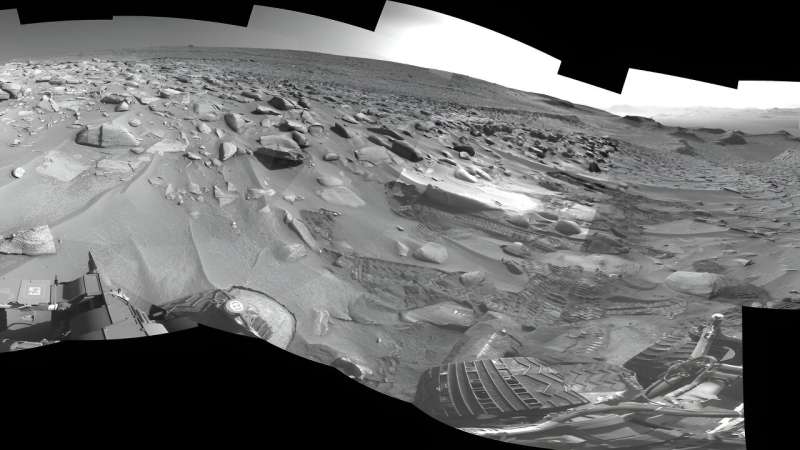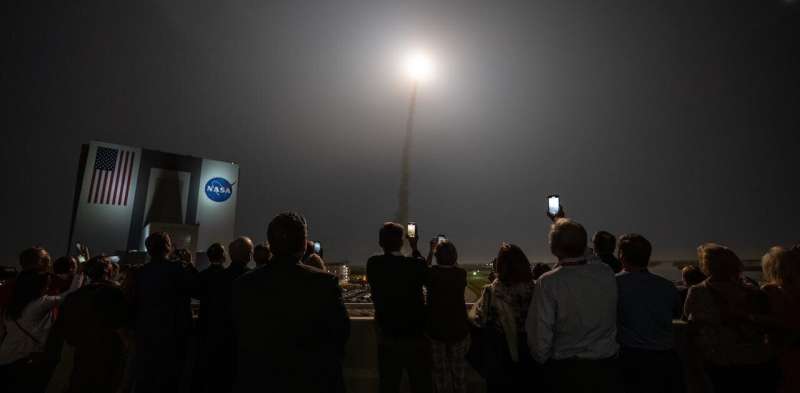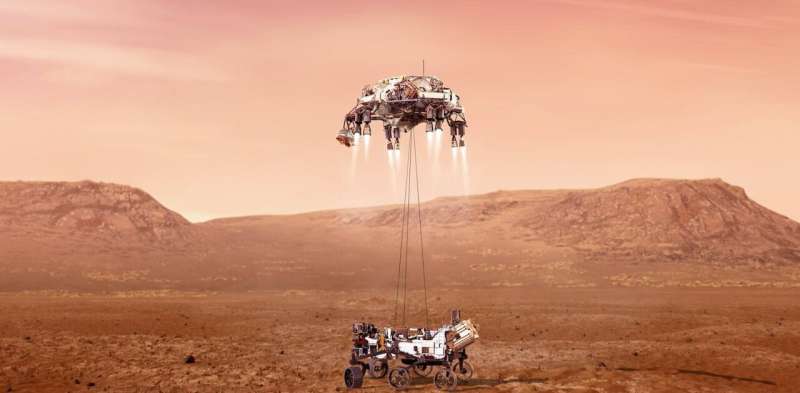Curiosity rover faces its toughest climb yet on Mars
Thursday, 03 August 2023 19:00
On Aug. 5, NASA's Curiosity rover will notch its 11th year on Mars by doing what it does best: studying the Red Planet's surface. The intrepid bot recently investigated a location nicknamed "Jau" that is pockmarked with dozens of impact craters. Scientists have rarely gotten a close-up view of so many Martian craters in one place. The largest is estimated to be at least as long as a basketball court, although most are much smaller.
SpaceX launches Intelsat’s last C-band clearing satellite
Thursday, 03 August 2023 16:51
The last satellite Intelsat needs to claim nearly $5 billion in total C-band spectrum clearing proceeds is performing well after launching Aug.
Most Americans support NASA but don't think it should prioritize sending people to space
Thursday, 03 August 2023 15:00
Most Americans (69%) believe it is essential that the United States continue to be a world leader in space. But only a subsection of that group believes NASA should prioritize sending people to the moon, according to a new report released by the Pew Research Center. The study surveyed over 10,000 U.S. adults on their attitudes toward NASA and their expectations for the space industry over the next few decades.
As scholars who study international relations in space and the history of the space program, we are interested in understanding how Americans view space activities, and how their perspectives might affect the future of both U.S. and global space developments.
US dominance in space
The United States' most visible effort to maintain world leadership in space is arguably its Artemis Program to land humans on the moon by late 2024.
If the world were coming to an end, what would be the most ethical way to rebuild humanity off-planet?
Thursday, 03 August 2023 14:36
Last week, scientists announced that for the first time on record, Antarctic ice has failed to "substantially recover" over winter, in a "once in 7.5-million-year event." Climate change is the most likely culprit.
Petra Heil, a sea ice physicist from the Australian Antarctic Division, told the ABC it could tip the world into a new state. "That would be quite concerning to the sustainability of human conditions on Earth, I suspect."
And in March, a senior United Nations disarmament official told the Security Council the risk of nuclear weapons being used today is higher than at any time since the end of the Cold War.
Both warnings speak to concerns about Earth's security. Will our planet be able to support human life in the future? And if not, will humanity have another chance at survival in space?
'Billionauts' and how to choose who goes
Over the past few years, we've witnessed the rise of the "billionaut." The ultra-wealthy are engaged in a private space race costing billions of dollars, while regular citizens often condemn the wasted resources and contribution to global carbon emissions.
iRocket collaborates with Air Force to develop reusable rockets
Thursday, 03 August 2023 12:33 Innovative Rocket Technologies Inc. (iRocket) has signed a cooperative research and development agreement (CRADA) with The Air Force Research Laboratory (AFRL) West to develop engines and stage technology for their next-generation fully reusable Shockwave launch vehicle. Members from AFRL's Rocket Propulsion Division at Edwards AFB, California, and iRocket, a privately-owned corporation, agreed
Innovative Rocket Technologies Inc. (iRocket) has signed a cooperative research and development agreement (CRADA) with The Air Force Research Laboratory (AFRL) West to develop engines and stage technology for their next-generation fully reusable Shockwave launch vehicle. Members from AFRL's Rocket Propulsion Division at Edwards AFB, California, and iRocket, a privately-owned corporation, agreed Hisdesat announces the launch of first SpainSat NG satellite for summer of 2024
Thursday, 03 August 2023 12:33 Hisdesat, the Spanish government satellite operator, has announced that the first satellite in the SPAINSAT NG programme, SpainSat NG-I, will be ready for launch in summer of 2024 after confirming that the programme is making good progress. The US company Space X will be in charge of launching the Spanish satellite into orbit with a Falcon 9 launcher, from its base at Cape Canaveral or from NASA
Hisdesat, the Spanish government satellite operator, has announced that the first satellite in the SPAINSAT NG programme, SpainSat NG-I, will be ready for launch in summer of 2024 after confirming that the programme is making good progress. The US company Space X will be in charge of launching the Spanish satellite into orbit with a Falcon 9 launcher, from its base at Cape Canaveral or from NASA HYDIS2 consortium project for hypersonic defence interceptor proposed for funding by the European Commission
Thursday, 03 August 2023 12:33 In May 2023, the HYDIS2 consortium, composed of 19 partners and more than 20 subcontractors across 14 European countries, submitted a proposal for a concept architecture and technology maturation study of an endo-atmospheric interceptor against new high-end emerging threats, in the framework of the European Defence Fund 2023 work programme. On the 12th of July 2023, following a positive evaluati
In May 2023, the HYDIS2 consortium, composed of 19 partners and more than 20 subcontractors across 14 European countries, submitted a proposal for a concept architecture and technology maturation study of an endo-atmospheric interceptor against new high-end emerging threats, in the framework of the European Defence Fund 2023 work programme. On the 12th of July 2023, following a positive evaluati Asteroid Institute Unveils Rapid Online Precovery Tool For Searching Multiple Astronomical Datasets in Minutes
Thursday, 03 August 2023 12:33 Asteroid Institute has launched a publicly available Precovery service that can both confirm and refine the orbits of asteroids by rapidly searching through a collection of astronomical data that has been curated and hosted on Google Cloud. The service, which runs on the Asteroid Discovery Analysis and Mapping (ADAM) platform and its unified observational dataset, can provide results in a matter
Asteroid Institute has launched a publicly available Precovery service that can both confirm and refine the orbits of asteroids by rapidly searching through a collection of astronomical data that has been curated and hosted on Google Cloud. The service, which runs on the Asteroid Discovery Analysis and Mapping (ADAM) platform and its unified observational dataset, can provide results in a matter Earth's most ancient impact craters are disappearing
Thursday, 03 August 2023 12:33 Earth's oldest craters could give scientists critical information about the structure of the early Earth and the composition of bodies in the solar system as well as help to interpret crater records on other planets. But geologists can't find them, and they might never be able to, according to a new study. The study was published in the Journal of Geophysical Research Planets, AGU's journal for
Earth's oldest craters could give scientists critical information about the structure of the early Earth and the composition of bodies in the solar system as well as help to interpret crater records on other planets. But geologists can't find them, and they might never be able to, according to a new study. The study was published in the Journal of Geophysical Research Planets, AGU's journal for NASA's trio of mini rovers will team up to explore the Moon
Thursday, 03 August 2023 12:33 Working together without direct human input, three rovers each the size of a carry-on bag will map the lunar surface in 3D, using cameras and ground-penetrating radar.
NASA is sending a trio of miniature rovers to the Moon to see how well they can cooperate with one another without direct input from mission controllers back on Earth. A teamwork-minded experiment to demonstrate new technolo
Working together without direct human input, three rovers each the size of a carry-on bag will map the lunar surface in 3D, using cameras and ground-penetrating radar.
NASA is sending a trio of miniature rovers to the Moon to see how well they can cooperate with one another without direct input from mission controllers back on Earth. A teamwork-minded experiment to demonstrate new technolo A new frontier for space in Australia with approval granted for a permanent commercial space launch facility in Koonibba
Thursday, 03 August 2023 12:33 Southern Launch and the Koonibba Community Aboriginal Corporation will begin work on Australia's first permanent commercial sub-orbital space launch facility after planning consent was granted for the Koonibba Test Range.
Southern Launch CEO Lloyd Damp says, 'The development of permanent, world-class facilities at the Koonibba Test Range will put Australia on the map as a space-faring nati
Southern Launch and the Koonibba Community Aboriginal Corporation will begin work on Australia's first permanent commercial sub-orbital space launch facility after planning consent was granted for the Koonibba Test Range.
Southern Launch CEO Lloyd Damp says, 'The development of permanent, world-class facilities at the Koonibba Test Range will put Australia on the map as a space-faring nati "Hoping for Frost" Sol 3906
Thursday, 03 August 2023 12:33 Earth planning: Tuesday, August 1, 2023: Today we wrapped a single-sol plan for sol 3906. Our planning for this sol was primarily constrained by power. We had attempted to conduct a frost experiment over the weekend which failed, and so we are striving to save power to be able to attempt the experiment again on Wednesday's plan. The blog post for that weekend's plan gives an excellent descriptio
Earth planning: Tuesday, August 1, 2023: Today we wrapped a single-sol plan for sol 3906. Our planning for this sol was primarily constrained by power. We had attempted to conduct a frost experiment over the weekend which failed, and so we are striving to save power to be able to attempt the experiment again on Wednesday's plan. The blog post for that weekend's plan gives an excellent descriptio Russia to launch first lunar station in nearly 50 years
Thursday, 03 August 2023 12:33 Russia's first lunar station in nearly 50 years, Luna-25, will fly to the Moon in the early morning of Aug 11, local media reported on Thursday.
According to Russia's RIA Novosti, the launch date is set for Aug 11 when the Soyuz-2.1b rocket with the Fregat upper stage and the automatic station will lift off from the Vostochny Cosmodrome, located in the Amur Oblast, at 2:10 a.m. Moscow time
Russia's first lunar station in nearly 50 years, Luna-25, will fly to the Moon in the early morning of Aug 11, local media reported on Thursday.
According to Russia's RIA Novosti, the launch date is set for Aug 11 when the Soyuz-2.1b rocket with the Fregat upper stage and the automatic station will lift off from the Vostochny Cosmodrome, located in the Amur Oblast, at 2:10 a.m. Moscow time Galaxy 37 Horizons-4 performing well after launch
Thursday, 03 August 2023 12:33 Maxar Technologies, provider of comprehensive space solutions and secure, precise, geospatial intelligence, has announced that the Galaxy 37/Horizons-4 satellite built for Intelsat is performing as expected after launch. The spacecraft was manufactured by Maxar in Palo Alto, California, and launched on a SpaceX Falcon 9 rocket from Cape Canaveral Space Force Station in Florida.
Shortly aft
Maxar Technologies, provider of comprehensive space solutions and secure, precise, geospatial intelligence, has announced that the Galaxy 37/Horizons-4 satellite built for Intelsat is performing as expected after launch. The spacecraft was manufactured by Maxar in Palo Alto, California, and launched on a SpaceX Falcon 9 rocket from Cape Canaveral Space Force Station in Florida.
Shortly aft China launches Fengyun-3 satellite
Thursday, 03 August 2023 12:33 China on Thursday launched a satellite into space from the Jiuquan Satellite Launch Center in Northwest China.
The Fengyun-3 06 satellite was launched at 11:47 am (Beijing Time) by a Long March-4C carrier rocket and successfully entered the planned orbit.
The launch marked the 481st flight mission of the Long March series carrier rockets.
span class="BDL">Source: Xinhua News A
China on Thursday launched a satellite into space from the Jiuquan Satellite Launch Center in Northwest China.
The Fengyun-3 06 satellite was launched at 11:47 am (Beijing Time) by a Long March-4C carrier rocket and successfully entered the planned orbit.
The launch marked the 481st flight mission of the Long March series carrier rockets.
span class="BDL">Source: Xinhua News A 
